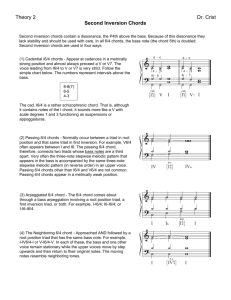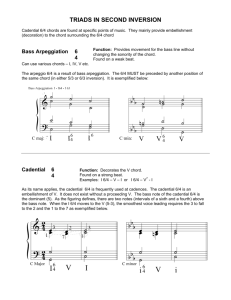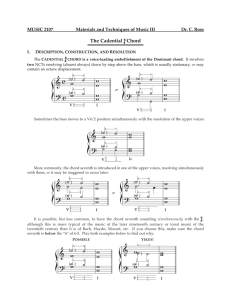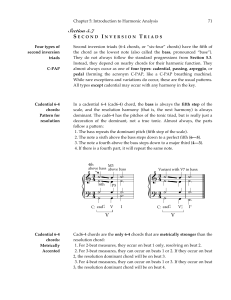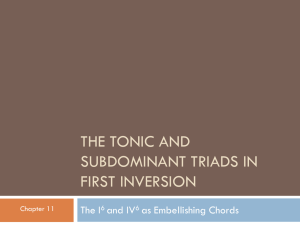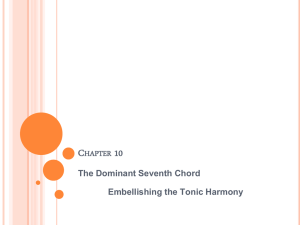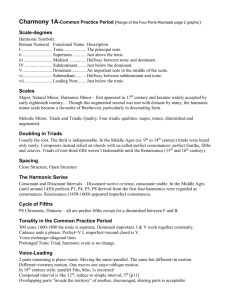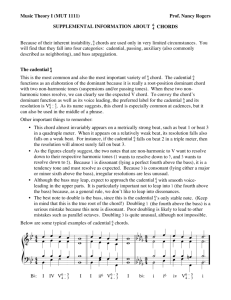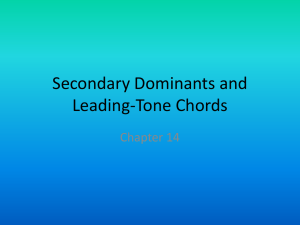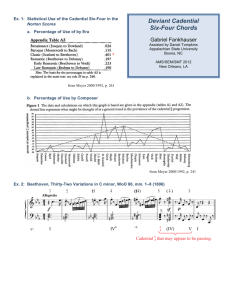Chapter 16
advertisement
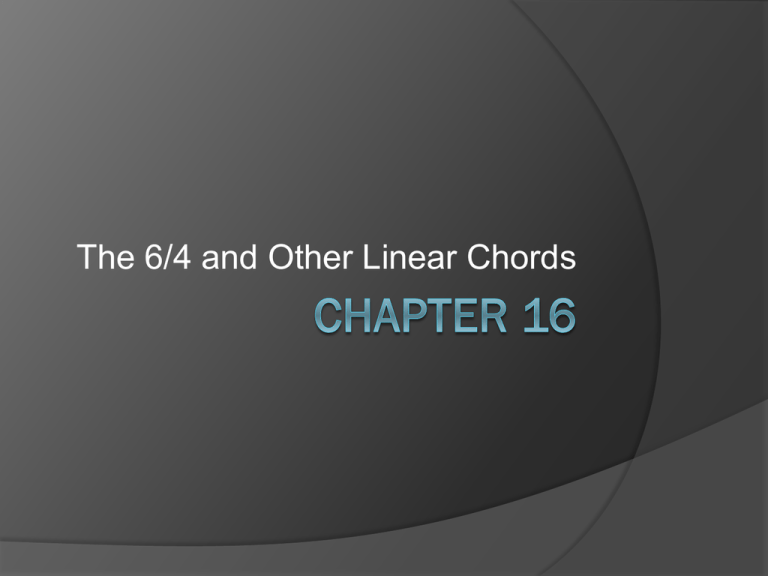
The 6/4 and Other Linear Chords The 6/4 and Other Linear Chords Root & First Inversion Triads (5/3 & 6/3) can be used freely – all consonant intervals 6/4 (2nd inversion) has dissonant 4th which must be approached and resolved correctly 6/4 functions linearly – comes between more stable harmonies; much like a viio6 between a I and I6 or a neighboring IV between two tonic triads Types of 6/4 Chords Accented Cadential Occurs at authentic or half cadence Unaccented Passing Between two harmonies Sustained or Pedal Over which a neighboring or passing chord occurs Arpeggiated The Accented/Cadential 6/4 Useful in the progression IV-V-I or ii6-V-I to help alleviate parallel 5ths Built on the 5th of tonic; however more closely attributed to a dominant harmony because it aurally lacks the stability of tonic Functions as an expansion of dominant harmony Accented/Cadential 6/4 I6 IV V Unintended //5th I I I6 IV V 6/4 I 5/3 Accented/Cadential 6/4 Accented 6/4 followed by root position dominant chord Dissonant 4th prepared by common tone from the previous IV and resolves downward by step (typical suspension) Frequently appears at an authentic cadence Soprano outlines (^4 -^3-^2-^1) but may appear as (^8-^8-^7-^8) Accented/Cadential 6/4 8 8 7 8 Cadential 6/4 indicated by Roman numeral as part of the suspended dominant function cm: i6 iv6 i Accented/Cadential 6/4 Dominant 6/4 to 5/3 sometimes may occur as a half cadence, with the final triad of the authentic cadence omitted This occurs frequently in slow movements of the Classical period Accented/Cadential 6/4 In partwriting… The bass note of the 6/4 is almost always doubled ○ This doubled note (^5) may remain or descend to ^4 (of a V4/2) on its way to ^3 Elaborating the Cadential 6/4 No matter the elaboration, the voice leading should always remain constant A: ii6 ( 6/5 6/4 5/4 V 5/3 ) I The Passing 6/4 Chord May occurs as a passing sonority between chords of similar function Invariably occurs on an unstressed beat Non-essential linear chord Passing V6/4 (2nd inversion) may function as a passing sonority linking a root-position tonic to a first-inversion tonic; I – (V6/4) – I6 or the reverse Commonly used to link two pre-dominant chords with stepwise motion Most common: IV6 – (6/4) – ii6/5 The Passing 6/4 Chord Eb: D: I6 IV6 6/4 (6/4) I ii6/5 V7 I The Pedal 6/4 Chord Features a sustained bass note over which the dissonant 4th may occur in either neighboring or passing motion The neighboring version in the first example shows the 5–6–5 3 4 3 voice leading progression over a stationary bass note. On both accounts the 6/4 chord is marked only with figured bass numerals. The Pedal 6/4 Chord Be careful when identifying the note that functions as the actual bass in accompanimental parts In most cases the first bass note of the measure of figuration is the real bass C: 5/3 5/3 6/4 (!) The recurring bass notes in m. 1-2 are not 6/4s. The bass note is sustained bass and root! Measure 3 is a legit 6/4. The F# in the 5/3 RH is a chromatic passing tone The Pedal 6/4 Chord In this case the dissonant 4th appears as part of a three-chord passing progression over the sustained or pedal bass. The Arpeggiated 6/4 Chord Created by having a broken chord or arpeggiation in the bass Usually extends over a series of measures rather than just one Other Treatments of the 6/4 See text pg. 278 – 279 for further examples and treatments of the 6/4 See especially the Beethoven (16.11b) and Scarlatti (16.11d) Cadenzas and the 6/4 Italian for cadence Written and performed for a solo instrument in a concerto; typical of Classical period works Usually virtuosic in nature; usually on thematic material from earlier in the movement Usually begins with an extended 6/4 followed by improvisations and movement toward the dominant A long trill on ^2 usually leads in to an orchestral tutti on the tonic harmony 6/4 Chords in Harmonizations Cadential 6/4 : 4-3-2-1, 8-8-7-8, or 2-8-7-8 when the second chord is 6/4 Passing 6/4: 7-(8)-2, prolonging dominant, or 4-(3)-2 & 6-(5)-4, prolonging pre-dominant Pedal, neighboring 6/4: 3-(4)-3 or 5-(6)-5 over tonic harmony or passing 2-(3)-4 over dominant harmony Other Diatonic Linear Chords Consonant Passing I Used when //5th are looming Helps link IV- V; stepwise in upper voice V – IV progression (inherently retro) Interrupted the tonic to dominant motion Appears frequently in sequences and in a standard blues progression Usually appears in major modes Other Diatonic Linear Chords V- IV Progression (continued) Sounds like a plagal cadence Delays tonic by rerouting it through the sub- dominant Frequent tool of Romantic composers Apparent Seventh Chords Arise out of linear voice leading Incorrectly analyzed as ii4/2 or ii6/5 ; they do not resolve properly (8-7) or progress to dominant When analyzing just provide the figured bass in parentheses Other Diatonic Linear Chords Interplay of Harmony and Melodic Dissonance Usually the origin of weirdo passing harmonies ○ Confusion comes with embellishing tones played simultaneously with reiterated chords ○ Do not give these chords Roman numerals or even begin to analyze them
